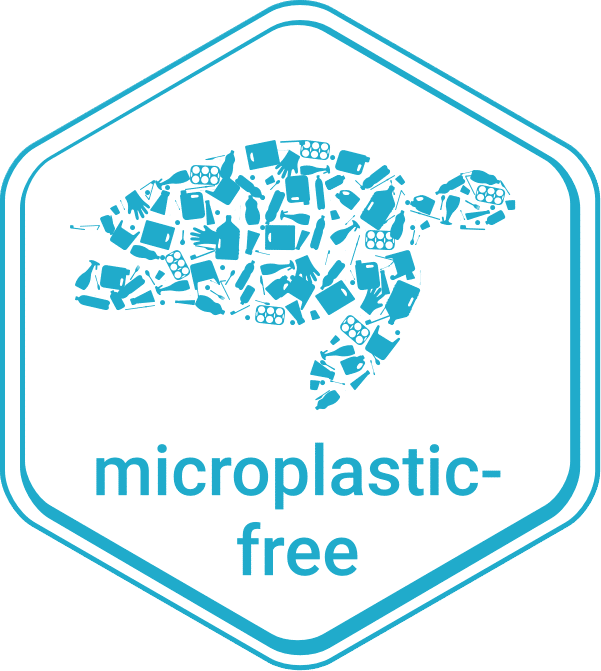Microplastic seal

According to the scientific definition, microplastics are tiny, solid and insoluble synthetic polymers that are not biodegradable and are less than five millimetres in size. Some particles are as small as 1000 nanometres. They are often barely visible to the naked eye. Of course, there are also particles that are even smaller. But then we no longer speak of microplastics, but of nanomaterials. This is already subject to mandatory declaration in the cosmetics sector, but microplastics are not (yet).
Microplastics can be divided into two categories: primary and secondary microplastics. The first category includes particles that have already reached the specified size range of microplastics when they enter the environment. Particles from the cosmetics and personal care segment belong to this category, as does the abrasion from car tyres. The second category, on the other hand, includes larger plastic particles that break down due to solar radiation or even wave action in the sea.
Why microplastics are so harmful to the environment
Microplastics get into our lakes, rivers and oceans through our wastewater, rainwater, but also through flooding. To date, sewage treatment plants can only filter it out to a very limited extent. Fish, mammals, worms, mussels and microorganisms then absorb these particles. Often through filtration, but sometimes also because they are mistaken for food or because animals eat other animals that have already ingested microplastics. The consequences for living creatures are fatal and range from tissue changes and inflammation to toxic reactions, severe internal injuries and death. Since microplastics are extremely persistent, they pollute our oceans for several hundred years. And more and more is being added. In the Arctic ice, one million particles per cubic kilometre could already be measured.
What is the point of microplastic seals?
Microplastic seals are intended to serve as a guide when shopping. Many retail chains are therefore increasingly labelling their microplastic-free drugstore products with a corresponding microplastic seal. However, the various microplastic seals define the term quite differently. While some follow the definition of the BUND, other seals prohibit all types of plastic in principle. There are also retailers who have their own definition of microplastics. However, almost all microplastic seals have one aspect in common. So-called bio-based polymers are usually not taken into account, so they can be used, even though they sometimes take decades to degrade or decompose. Both NABU and Deutsche Umwelthilfe are therefore calling for bioplastics that degrade poorly to be banned as well. In this context, they even go so far as to warn of dangerous greenwashing by bioplastics. So far, however, only the microplastic seal Flustix is backing a ban on bioplastics.
The INCI designations of microplastics
Microplastics can be recognised in cosmetic products on the list of ingredients by the following INCI designations, among others:
– Acrylates Copolymer, Acrylates Crosspolymer
– Butylene/ethylene/styrene copolymer
– Ethylene/methacrylate copolymer
– Polymethyl Methacrylate, Polyacrylate, Polyethylene (PE), Polyquaternium
– Polyethylene Terephthalate (PET), Polypropylene (PP), Polystyrene (PS)
– Polytetrafluoroethylene
– Polyurethane (PUR)
The European Commission’s draft on the limitation of microplastics of 30 August 2022 (D083921/01)
The recently published EU draft implementing law includes almost all products with microplastics: cosmetics and fragrances, biocides and even medical products. There are only a few exceptions: Pharmaceuticals, for example, but also in vitro diagnostics. This means that many manufacturers will have to change the composition of their products. However, there are to be transitional periods for the entry into force of the decisions. This should give producers enough time to develop suitable alternatives. For example, a transition period of four years is planned for microplastics in wash-off cosmetic products, and five years for leave-on cosmetic products.
Microplastic seal: Cosmacon now with its own certification
We at Cosmacon are aware of our responsibility for our environment and do not want to remain inactive on this important issue. That is why we now offer our own certification. For this certification, the raw materials are strictly and critically checked by an independent safety assessor, in accordance with the current EU definition. For you, this microplastic seal offers several advantages. You signal a sense of responsibility to your target group and can further enhance your image as a trustworthy brand. Moreover, certified products are not just a trend, but the future. The complete process only takes a maximum of ten working days and we only charge a one-time fee of 250 Euro. Are you interested in guaranteed microplastic-free products that you can offer to your target group? We are at your disposal for your questions and for further information on our microplastic seal!
Microplastic-free? Yes of course!
Microplastics are a very serious problem that massively threatens our lakes, seas and rivers. Everyone can already do something about it: by only buying products that are truly plastic-free. A glance at the INCI list is enough, especially since the names of the suspicious ingredients are memorable after a short time. We can also help to ensure that our waters are not further threatened: with certification or a microplastic seal that is based on the strict specifications of the EU Commission. If we all join in, we will make a valuable contribution to protecting our environment.
